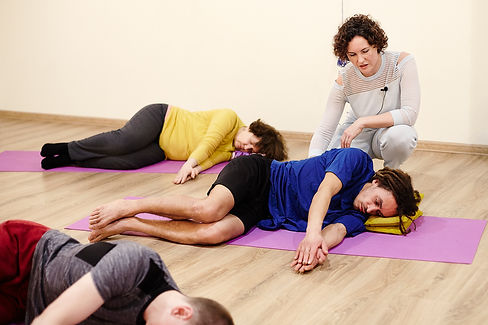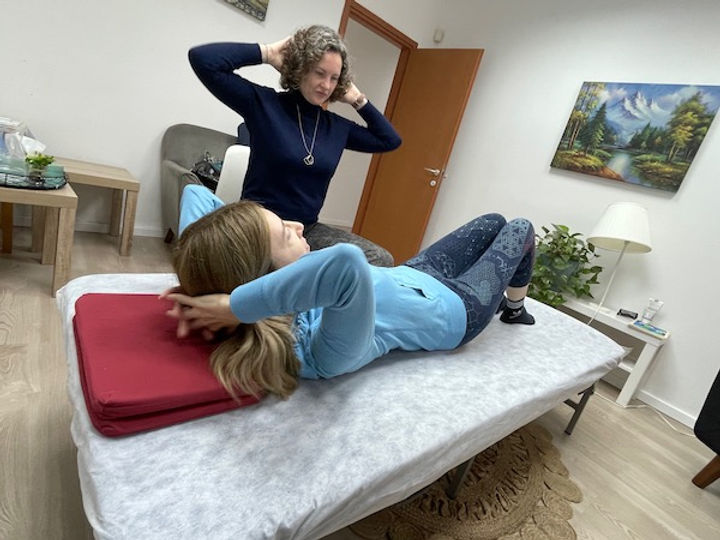

12 Years of Healing Through Somatic Practice
I'm Dr. Katya Zilbershteyn, a specialist in somatic education and psychology, helping people reconnect with their bodies, release tension, and find balance.
-
Ph.D. in Psychology
-
Certified Hanna Somatics Educator
-
Assistant Trainer at The Ingle Institute of Somatic Movement Education
-
Feldenkrais Method Teacher (Rywernat Tradition)
-
Guest Expert in the Integral Leadership and Personal Maturity Program "Evolution"

I work with individuals and groups, integrating Hanna Somatics, the Feldenkrais Method, and trauma-informed bodywork to support nervous system regulation and enhance movement awareness.
I firmly believe that through mindful movement and deep body awareness, we can strengthen resilience, relieve chronic tension, and unlock our full potential. I look forward to connecting and exchanging knowledge in the field of somatic practices and embodied well-being!
Somatics for me is a way to stay alive.
When I look around, I see how disconnected people are from their bodily experiences, how they spend most of their lives "in their heads," often unaware that they can pay attention to their bodies, not just when something hurts. This simple idea forms the foundation of somatic learning: you can return your attention to your body and start to become aware of what is happening within. It's incredible, but people visibly become happier. I witness this every day. When a slouched person with a dull gaze leaves the room with eyes sparkling, with desires, with a dancing walk, as if they've shed decades from their shoulders, it's truly remarkable. What's even more surprising is that people become kinder to themselves. They start to feel how they themselves tense their shoulders, tighten their hips, how they hold themselves back from moving, how they freeze and hold their breath.
When a person starts to realize what they are actually doing, they gain the power of choice.
My diploma and professional education:
-
Feldenkrais Method - 4-year training (Elisabet Bloom Approach)
-
Somatic Experiencing® - entry level (SETM International)
-
Certified Somatic Educator (The Ingle Institute for Somatic Education)

WHAT IS SOMATICS?
Somatics is an approach to human development and learning through movement.
Somatic sessions are based on principles of biomechanics, neurology, and neuroplasticity, the brain's ability to change as a result of experience. Using strategies of neuromuscular retraining, somatics helps individuals develop body awareness, improve posture, flexibility, and coordination, enhance athletic and artistic abilities, and support those dealing with stress, trauma, limited mobility, chronic pain, and muscle tension. The practice of body awareness is offered in both group and individual lesson formats.
Thomas Hanna was one of the first to propose that our body can "learn" through movement. He developed the concept of somatics, which shows that we can consciously work with muscular tension and holding patterns to restore freedom and natural ease to the body.
Moshe Feldenkrais was the founder of the Feldenkrais Method, which focuses on how we move and perceive our bodies. His approach is based on the idea that through gentle and mindful movement, we can improve coordination, enhance flexibility, and even reduce pain.
Somatics is not about "pushing through," "powering up," or doing things because you
"should." It's a completely different approach to the body - one that is gentle, respectful, and deeply aware.
Here are the key principles:
1) Move slowly. We move slowly so the brain has time to notice what the body is doing. When we slow down, we gain the ability to feel our movements rather than just repeat them
automatically.
2) Stay aware. We don't just perform exercises - we observe sensations: Where is there tension?
Where is it easier? What's changing? It's a dialogue with the body, not a set of commands.
-
Stay in your comfort zone. No pain, no forcing, no pushing through. We respect the body's boundaries and only move into what feels comfortable. That's exactly where true change begins.
-
Be curious and attentive. The goal isn't to do something "better," "higher," or
"stronger," but to understand, sense, and learn something new. It's an exploration:
What if I do this differently?
5) No rush, no expectations. Each session is a chance to give the body and nervous system space to restore and recalibrate.
We're not rushing, comparing, or demanding — we're simply learning how to be with ourselves.
Somatics is like a quiet conversation with your body - not a competition.

Somatics in simple terms
The word "somatics" might sound a bit scientific and distant, but in reality, it's about something very personal-it's about you, your body, and how you experience it.
Imagine you've had a stressful day. You sit down on the couch in the evening, but your shoulders are still tense, your breathing is shallow, and your jaw is slightly clenched.
The day is over, yet your body hasn't relaxed-it's still holding onto stress. Or the opposite: you take a walk in the forest, inhale the fresh air, slow down. And suddenly, you notice-your body has relaxed on its own. Your breath is deeper, your chest feels lighter.
That's what somatics is-awareness of how your body experiences life along with you.
Unlike traditional medicine or fitness, where something is done to the body (healing, training, correcting), somatics invites you to listen and notice. It's not about forcing change, but about creating a dialogue with yourself.


What Does the Somatic Approach Offer?
-
It helps you listen to your body and understand its signals—not ignoring pain until it becomes unbearable, but noticing it early.
-
It reduces stress levels, preventing tension from building up in your muscles and nervous system.
-
It develops sensitivity and a deeper connection with yourself, which affects not just your body but also your emotions, relationships, and decisions.
Somatics isn't about complicated techniques. It's about slowing down and feeling— How am I standing? How am I breathing? What's happening with me right now? Simple things that change a lot. Do you notice how your body reacts to stress, joy, or fatigue?
How it experiences life along with you?
Psychosomatics vs. Somatics: What's the Difference? The words sound similar, but they mean different things! Let's break it down in simple terms. Psychosomatics studies how stress, emotions, and mental states affect physical health. For example, when your stomach aches from worry or you get a headache from stress—that's psychosomatics at work. It focuses on the question: "What in my mind is causing these physical symptoms?"
Somatics, on the other hand, looks at things from the body's perspective. It's about noticing: "How does my body feel right now? Where is there tension? How am I moving and breathing?" Somatics helps improve well-being through mindful movement and body awareness.
Key Differences: What they focus on: Psychosomatics: How emotions and stress can cause physical issues. Somatics: How body sensations connect to mental and emotional states. How they work: Psychosomatics: Finds the cause of physical symptoms in the mind. Somatics: Helps you tune into your body to release tension and feel better. Why does it matter? Understanding these differences helps you choose the right approach to self-care. Sometimes, exploring your emotions (psychosomatics) is helpful, while other times, you just need to slow down, feel your body, and let go of tension (somatics).

There’s a simple, yet often uncomfortable truth: to see real results, you need to practice regularly.
Just like brushing your teeth or getting enough sleep. Once a month is better than nothing, of course — but for lasting change, you need to return to the practice again and again.
I often hear from new participants:
“It felt like we barely moved, but my posture improved!”
“I hardly moved, yet my back pain went away.”
The secret isn’t in the intensity — it’s in the quality of attention. In how you move and the connection you build with your body. And most of all — in consistency.
Somatics isn’t about strength or endurance. It’s not about pushing limits or achieving goals.
It’s about restoring connection with your body. About gentle, mindful movement. About coming back to the feeling: “I’m at home, in my body, and it feels good.”
That’s why it’s especially helpful for:
-
People recovering from injuries or surgeries, for whom fitness or even yoga is too intense
-
Those who don’t enjoy or can’t go to the gym due to pain, fatigue, or self-consciousness
-
Anyone living with high stress or anxiety — somatic practice gently regulates the nervous system
-
People who want to care for themselves differently: not through “musts” and strict schedules, but through curiosity, attention, and exploration
What Makes Somatics Different From Other Body Practices?
-
It’s not a workout — it’s an exploration. There’s no goal to "sculpt your abs" or "improve your flexibility." You’re not working toward a result — you’re building awareness. And paradoxically, that’s when results start to appear.
-
It’s not about doing — it’s about feeling. Sensation matters more than the correctness of the shape. Making mistakes isn’t bad — it’s a resource for learning.
-
No suffering required. There’s no pushing through pain, no “just one more rep,” no “you have to endure.” You’re allowed to stop, shift, or change your mind. Respect for your body comes first.
-
No judgment. Somatics isn’t about “better or worse,” “flexible or stiff.” It’s about “this is what I feel now” — and how that might shift.
Because the nervous system learns through repetition. If once a week you come back to gentle movement, notice your breath, pay attention to how your neck or pelvis feels — your brain starts building a new body map. And with it, new possibilities emerge.
Chronic tension begins to melt.
Lightness appears.
Breathing deepens.
Posture becomes more natural.
Sleep improves.
Your mood stabilizes.
I recommend practicing for 1–2 hours a week. And if you can, just 10 minutes a day — tuning into your body: breathing, noticing the support of the ground, doing a movement or two with care.
This doesn’t take strict discipline. Just attention and gentleness.
The effects accumulate.
After a couple of months, you might suddenly notice you feel completely different — calmer, freer, more confident. If this speaks to you — come try one of my sessions. They’re designed for those who want to return to the body with care and without pressure or shame. With curiosity, gentleness, and the kind of consistency that supports — not overwhelms.








